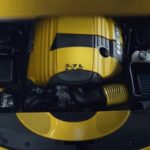Water Filtration by Clearsource
For any motorhome owner, water is a resource that’s taken for granted. You pull in, you hook up and you have water. Many owners use a filter to improve water quality and Clearsource, a Southern California company that specializes in water filtration, has developed custom brackets and premium water systems designed specifically for motorhomes.
Using two cartridges offers significant protection. Handling two connected filters can be cumbersome, so Clearsource houses them in a stout chassis that features high-end fittings and solid canisters.
Two 10-inch canisters are mounted in a powder-coated, 15” tall by 14¼” wide by 7½” high metal chassis. It doesn’t flex and the chassis can be positioned on the ground with total stability. After only a few uses, it became apparent that this heavy-duty system should last as long as the motorhome.
Stainless-steel fittings mate the two canisters and offer corrosive-resistance connections to the water hoses. Buttress threads and large O-rings offer a leak-free environment for the canisters, which can be tightened and removed with the provided plastic wrench. Don’t over-tighten the canisters. The O-rings will provide the watertight seal without you feeling the need to hulk up on the wrench. Remember it’s only plastic.
Two filter cartridges are preinstalled in the system and replacements can be ordered directly from the company. The filter element is designed to remove sediment down to 5.0 microns. A four-layer structure does a good job of retaining particles, and after a short while it was evident (upon a visual inspection) that this media removes a large amount of unwanted contaminants, like silt and sediment. The filters are made of 100 percent polypropylene that meets FDA CFR Title 21 requirements for use with food and pharmaceuticals. The second stage filter employs acid-washed coconut-based activated carbon. High purity coconut shells and the 0.5 micron rating assure that pesticides, cryptosporidium and giardia cysts will be removed from the water, according to the company.
Clearsource rates its filters to produce 2,000 gallons of water before needing replacement. Under normal conditions, with typical use of a motorhome, that should provide up to a year before replacing the filters. Full-timers will likely replace filters every two or three months, although we found them to last quite a bit longer. Replacement filter packs sell for $29.95.
Longer use of the filters may lead to a reduction in water pressure, which is tested at the factory at 40 psi. Storing the filters between trips is simple. Non-use for up to two weeks requires no maintenance. We drained the water before storing the system in an outside compartment to prevent sloshing during travel. Turn the chassis on its side to let the water to flow out of the fittings. If the filters will be unused for a month or longer, the canisters should be drained and the filters placed in dry storage. Once water is reintroduced, the filters will reactivate. Those who prefer to sanitize the canisters after long storage can use cleaning tablets sold for hydration bladders popular with hikers and bicyclists.
Owners concerned with possible theft can run a cable through the chassis and lock it to a logical place on the motorhome frame.
Clearsource provides rotating connection points that make hookup easier. Quick-connect couplings speed up the process and owners should use quality fittings to prevent unintentional disconnections.
The external system retails for $275, but the versatility is unsurpassed when it comes to water filtering and conditioning. Clearsource offers a rust-inhibiting filter that does a commendable job of reducing staining.
As an external system, the Clearsource filters and chassis can be placed virtually anywhere outside the motorhome. It’s always best to locate the filters out of the sun, which can be accomplished easily by scooting the system under the motorhome. It should not be used inside a compartment since a burst hose or bad gasket can lead to water damage.
Owners who have room in their utility compartment can consider the company’s onboard system that’s designed to be mounted on a wall. Using an equally stout chassis, albeit much smaller and lighter, kits are available in two- or three-filter arrangements. The two-canister onboard system uses the same filters that are packaged with the external chassis; the three-canister product comes with an additional 0.2-micron filter that provides another layer of water cleaning. Those who have the room for three canisters can integrate a rust-inhibiting or other type of filter into the system, depending on conditions. A sulfur-reducing filter is available for $19.95 and a deionizing product that reduces dissolved solids to almost zero sells for $39.95. Deionizing filters have limited capacity, and are designed to prevent water spotting when washing a vehicle. Two-stage onboard systems sell for $275 and the three-filter configuration has a $350 price tag.





